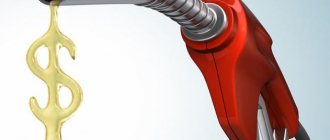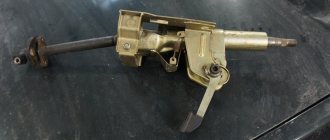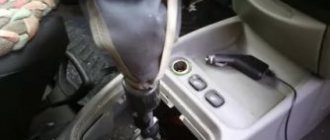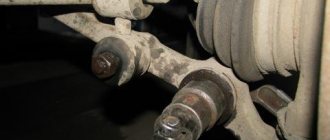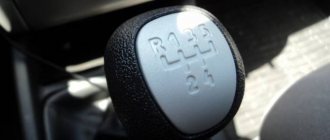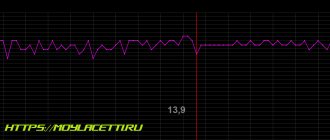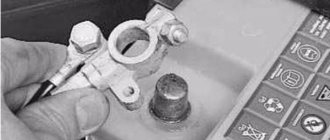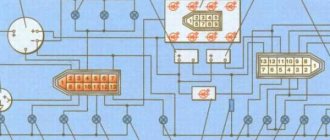Backlash is a term in mechanics that implies the presence of free movement in an element of a mechanical system. It represents a parameter by which one can judge the amount of movement of the node mentioned above to obtain a response from another - the controlled node.
In other words, the amount of backlash is characterized as the amount of rotation or displacement of the controlled element, which does not lead to any changes in the object.
In relation to a car and steering, the angle of rotation of the steering wheel at which the car continues to move in the same direction.
What is meant by total steering wheel play?
Another term that requires consideration is “total backlash.” It refers to the total angle, which starts from the extreme position of the steering wheel on one side when turning begins, to the opposite position when the car starts moving in the other direction.
To understand the principles of operation of the total backlash, it is important to understand the design and operating features of the control system. Based on the technical component, the operating principle of the backlash is as follows.
There is a rod in the transmission of steering rods, which is fixed with a small gap of one or two millimeters.
This distance is necessary to protect the steering system linkages from wear due to excessive friction.
The presence of a gap is a technological solution that allows you to keep the hook in the required position and not touch the surface of the teeth.
For the driver, this parameter represents free movement of the steering wheel, which allows for more precise control of the car and to feel at what moment the direction of movement of the vehicle changes.
Essentially, this is the total distance the steering wheel travels before the car moves to the left or right.
Many people mistakenly consider this phenomenon negative and try to get rid of it. You shouldn’t do this, because play in the steering is the norm for every car. Another thing is that it must have a strictly defined value.
An interesting pattern can be traced here - the larger the car’s dimensions, the higher the backlash indicator.
In the process of measuring the total backlash, a number of conditions must be met:
- The front wheels are located in a neutral position and stand on a hard (asphalt or concrete) surface.
- The steering wheel tires are dry and clean.
- The car engine is started. This is relevant if the operation of the power steering is tested.
- The tension of the power steering pump drive belt, as well as the level of the working fluid, must meet the requirements approved by the manufacturer.
The total play is checked by measuring the angle of rotation of the control wheel between the fixed positions for changing movement to the left and right.
To obtain accurate parameters, measurements are made two or more times.
Total play in steering
The total play in the steering, according to the Road Traffic Regulations, should not exceed 10 degrees. In fact, even a small amount of play creates a lot of inconvenience for the driver, such as knocking noises when driving on a bad road, or the car yawping along the road.
Sooner or later, a small play will become large and it will become completely impossible to drive, so it is necessary to correct its value as soon as possible.
Free play is not considered play. It can be in one or several elements of the steering device. There is a way to determine in which of them there is play: one person should rock the wheel from one side to the other within the limits of the play, and the other should watch the ball ends of the tie rods and the universal joint near the steering rack or worm, if the gear is a worm.
We recommend: Operating principle and features of turbocharging on gasoline and diesel engines
Attention is also drawn to the connection of two rods, which fit tightly into one another. This connection is made to prevent the transmission of force to the steering wheel in the longitudinal direction at the time of an accident when the front part of the car is crushed.
Broken ball joints announce themselves in advance with a characteristic knock. As a rule, this happens before noticeable play appears. Replace and repair them.
Permissible backlash in cars
The traffic regulations stipulate normalized indicators of total play for various cars. In addition, this parameter should not exceed the figures specified in the documentation for the operation of the machine.
If there are no special recommendations in the manufacturer’s papers, the backlash should be as follows:
- For passenger cars, as well as bus and truck components made on their basis - 100;
- For buses - 200;
- For trucks - 250.
There are also separate recommendations for some models:
- For VAZ-2106, 2107, 2110, 21213 - 50;
- For Gazelle 3302 - 200 (passenger version) and 250 (truck).
Reasons for large backlash
The increase in play can be explained by changes in the design features of the steering, as well as the destruction of their elements.
The main reasons include:
- Worn gear bar and steering rack gear teeth.
- Damage or deformation of the wheel bearing. There are cases when it falls apart during operation, which leads to an increase in backlash (but there will be no time for backlash).
- Malfunction of tips and tie rods, which often break if operating requirements are not followed. The result is the same as in the previous case - “looseness” of the steering wheel.
- Poor quality repair of the vehicle chassis. There are situations when steering play manifests itself after visiting a service station. This is possible when service technicians do not tighten the wheel bearing nut sufficiently. As a result, the car's steering system suffers.
- Breakage of the ball joint (lower or upper), as well as pulling the steering rack with excessive force.
- Outdated hydraulic oil that requires replacement. Often play in the steering is eliminated after filling with new working fluid.
Generally speaking, play occurs when there is a fault in the chain between the steering wheel and the wheels.
To find out the reason, you need to go through the entire chain and identify the “weak” points. The main thing is to make sure that we are talking about increased free play, and not about other problems.
Other causes of play in the steering include:
- Wear or incorrect adjustment of the engagement of the “worm” and the roller mechanism.
- Worn swing arm axle or bushings.
- Loose crankcase fasteners.
Causes of backlash
After a long period of operation, the working surfaces of the roller, bearing, bushing, washer, bipod shaft and its T-shaped groove, and the head of the adjusting screw become unusable. Thus, the gaps in the steering device increase, while the car is moving, extraneous knocks and vibrations appear, the wheels become unstable and wobble. Initially, a gap appears at the point of contact between the roller and the worm; subsequently, simultaneously with the steering shaft, an axial displacement of the worm occurs.
When traveling at high speed, the car becomes uncontrollable, which can lead to serious consequences, including an accident.
The main reason for the occurrence of backlash is the disgusting condition of the roads. The car's suspension takes on the bulk of the load, which is directed to the wheels, but some of it still falls on the steering parts. The situation is aggravated by the use of low-quality rubber, which significantly reduces the service life of the steering rod and suspension.
Loosening the nut
The “innocent” cause of the malfunction is the loosening of the steering wheel nut. Adjustment is performed by tightening the screw in the end cover of the steering mechanism. First, the decorative element of the fastening casing is removed, then the nut is tightened with a socket wrench of the required diameter.
If an airbag assembly is installed in the car trim (this applies to modern cars), it must first be dismantled to provide access to the nut. Work is carried out with the battery terminals disconnected in order to comply with safety precautions.
Important! If you do not tighten the fastening nut in a timely manner, this will lead to wear of the splines in the place where the steering wheel is attached, resulting in the steering wheel turning and loss of vehicle control.
Wear of rod ends
A more dangerous cause of play in the steering is wear of the rod ends. Due to the fact that these elements operate in difficult conditions, being constantly exposed to dirt and water, they deteriorate faster. As a result, the axial and radial clearances in the ball joint of the tip increase, it falls apart and driving the car becomes impossible. To avoid the consequences of such a malfunction, you should immediately contact service to replace parts.
Also, there are several reasons for the formation of free play, hidden in the design of the steering system.
- collapsed wheel bearing;
- loosening or improper tightening of the steering wheel nut and adjusting rods;
- wear of the ball joint;
- depreciation or breakage of hinges, splines, driveshaft joints;
- excessive gap between the toothed bar and the gear, or their wear;
- unsuitable hydraulic oil.
Signs of breakdown
As noted above, in order to effectively eliminate a malfunction, it must be diagnosed in a timely manner. To do this, it is enough to know the signs of play in the steering.
The main symptoms include:
- The appearance of a knock in the steering mechanism;
- Increased vibrations while driving;
- Creaking when turning wheels;
- Deviation from a given trajectory when the steering wheel is in a straight position.
When adjusting the steering play, you should take into account the manufacturer’s recommendations and traffic rules.
The configured parameter should not exceed the upper limit, but you should not underestimate the indicator either.
Too little steering wheel play can lead to additional discomfort and poor vehicle controllability.
At the same time, you should not ignore the appearance of a small backlash, because over time this parameter may increase, and then it will be more difficult to deal with the problem.
And it’s inconvenient to drive a car when you constantly have to “catch the road” and turn the steering wheel in one direction or the other.
Also read about the causes of knocking when turning the steering wheel.
Principle of operation
To understand what steering play is, consider the principle of operation of steering systems in a modern car. The steering wheel is connected through a cardan joint to a mechanism that is a hollow (usually duralumin) tube, inside of which there is a gear rack moved by a gear connected to the cardan joint. The rack is connected through internal tips to rods, which are connected through external hinges to the steering arms on the front suspension struts. Thus, any movement of the rack leads to the rotation of the wheels and any play in the steering can lead to serious consequences from a delayed reaction to movement to a complete loss of control of the car.
We recommend: Basic characteristics of oils for diesel engines
Reasons for play in the steering:
- poor tightening of the steering wheel nut;
- wear of spline joints;
- wear of the cardan joints of the intermediate shaft;
- loosening of the steering mechanism to the body;
- increased gap between the rack and gear in the mechanism;
- tip wear;
- wear of the rubber-metal hinges securing the rods to the mechanism or weakening of their fastening bolts;
- loosening the adjusting rods.
The play may be accompanied by a knocking sound in the steering column, which may indicate wear of the parts.
Diagnosis of the problem and instruments used
To determine whether the parameter corresponds to the norm, you need to do a small check.
To make sure there is a problem, you can use a special device - a backlash meter.
With its help you can check the total (total) play in the system.
One of the device options is K 524 M or ISL-M, which can be used by ordinary car owners and professionals at service stations.
Using a backlash meter, it is possible to determine the amount of free play in just three minutes, including taking into account installation and removal of the device.
The algorithm for diagnosing steering play is as follows:
- Start the engine (it should be idling);
- Place the front wheels parallel to the longitudinal axis of the machine. At the same time, make sure that the hydraulic booster is working;
- Turn the steering wheel one way and then the other. At this moment, record the moments when the front wheels begin to scroll in the required direction. The distance that the steering wheel travels between these intervals is called play (free play).
This check is considered an excellent option for drivers who need accurate and quick information.
It does not matter how the problem was diagnosed. If the steering play exceeds the norm, it must be eliminated.

